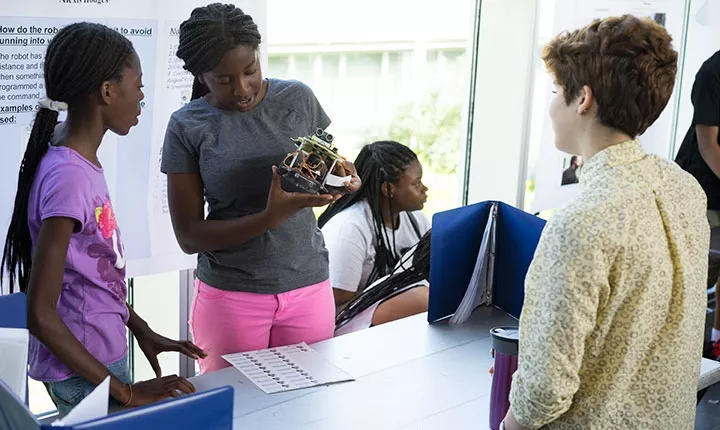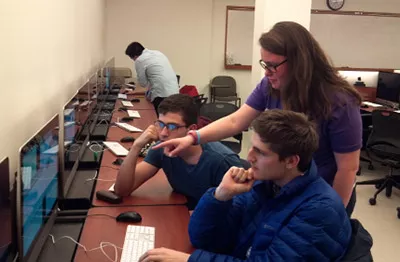Swarthmore Recognized for Sustained Science Education Excellence

Students in the 2015 Science For Kids (SFK) program present their research at a Science Fair in Eldridge Commons.
For the past 28 years, research opportunities for science students at Swarthmore College have been supported by grants from the Howard Hughes Medical Institute (HHMI). In 2012, HHMI recognized Swarthmore and 10 other small colleges with a Capstone Award for their sustained excellence and important contributions to undergraduate science education.
HHMI asked Capstone awardees to engage in a comprehensive assessment of their programs that were developed by support from HHMI. For Howard A. Schneiderman '48 Professor of Biology and HHMI Grant Program Director Kathy Siwicki, that meant looking back to see to what extent the research experiences created by HHMI have affected students. What she discovered was overwhelmingly positive.
With help from Institutional Research, Alumni Records, Development, and the Provost’s Office, Siwicki and HHMI Program Coordinator Beth Svenson discovered that natural sciences and engineering (NSE) majors and minors who participated in summer research enroll in post-college education programs at higher rates and earn Ph.D.s at higher rates than those with no known research experience. For NSE students who graduated between 1999 and 2005, one-third of those who had participated in summer research eventually completed Ph.D. degrees. This result held across demographic groups.
“HHMI funding has really changed Swarthmore’s NSE division,” Siwicki says. “The research culture here is far more robust and vibrant than when I arrived 27 years ago. Our HHMI grants have stimulated the development of a lively summer research culture”
That result is easy to see—the Science Center buzzes with activity and students during the summer months, while in summers past the campus would empty out. Beyond working closely with professors, the students’ summer experience also includes a career panel, an alumni panel, and social events.
Originally, the grant supported 12-15 students annually and peaked at 40 students in 2008. There are currently 20 students supported by HHMI this summer; however, the College is independently supporting many additional students. Siwicki points out, “Across campus, the College has significantly increased resources for summer research students. There is more than twice the College support now than there was even eight years ago.”

Science Associates, the popular peer-learning program that includes CS Ninjas and Engineering Wizards, got its start through HHMI funding.
While the grant has provided a consistent emphasis on summer research, allowing students and faculty to work together in close relationships, Svenson and Siwicki note that it has also helped develop a culture of inclusion by promoting persistence in science for students from groups that are historically underrepresented in the various fields.
To further this goal, the HHMI grant has allocated a subset of summer fellowships to first- and second-year students who were underrepresented minorities and/or first generation students. Additionally, faculty and staff could apply for mini-grants to support a range of enrichment options, such as covering expenses for a student to travel to a conference or creating a stipend for a student to pursue an unpaid internship.
Focusing on inclusion and persistence has proven successful. For example, 88 percent of first generation and underrepresented minority students who received HHMI summer research fellowships persisted to graduate as NSE majors. By 10-15 years after graduation, 85 percent of first generation students and underrepresented minorities with summer research experience completed post-Swarthmore degrees, a higher rate than any other subset of NSE majors. Additionally, in the fields where women are traditionally underrepresented, Swarthmore women with summer research experience completed Ph.D.s at an equally high rate as men.
Though summer research has been a key component over the years, HHMI grants have had an impact across the NSE division. They have allowed for curriculum development, including Associate Professor of Physics Catherine Crouch’s popular Introductory Physics for Life Science courses, which has life science students “loving physics in a way they didn’t know they could,” says Svenson. The grants have also supported peer-learning initiatives, such as the Science Associates; purchased new equipment that’s used both for research and in lab courses; and supported the development of the new biology scholars program.
HHMI grants also have funded the Science for Kids (SFK) program for the past 12 years, which has been a strong component of the summer research experience. SFK was created to encourage a love of science among fifth to eighth graders as well as to foster mentor and role model relationships between the children and the College student volunteers and teachers. During the Chester Children’s Chorus' 5-week summer camp on Swarthmore's campus, about half the chorus members go to the Science Center at lunchtime every day to participate in science workshops taught by Swarthmore faculty, instructors, and undergraduate SFK counselors.
“All of these things work together to create the impact,” says Svenson. “The research alone is not the only indicator that led to the results.”
Siwicki says the relationship with HHMI has been profoundly gratifying. “The grant funding has strengthened science education at Swarthmore and allowed for a lot of multi-faceted programming supporting diverse initiatives.”
Visit Supporting STEM Success in a Liberal Arts Context for the expertise Swarthmore and other Capstone Award colleges have developed over the years with support from HHMI.



